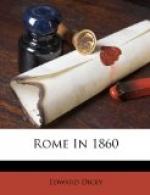Out of chill clouds and dull gloom, I passed into summer sunshine. Across barren moor-land and more barren mountains, by the side of marshy lakes, deserted and malaria-haunted, through squalid villages and decayed cities, my journey brought me into a rich garden-country, studded with thriving towns swarming with life, and watered with endless streams. I came into a land such as children of Israel never looked upon from over Jordan, after their weary wanderings in the wilderness; a land rich in oil and corn, and vineyards and cattle; a very “land of promise.” This, indeed, is the true Italy, the Italy of which all poets of all time have sung; and whose likeness all artists have sought to draw, and sought in vain. The sight, however, of this wondrous beauty was not new to me who write; still less is its record new to you who read. With this much of tribute let it pass unnoticed. Fortunately, it was my lot to see the promised land of Italy as for centuries past she has not been seen. I saw her free, and rejoicing in her freedom. Then let me seek to recall such of the epochs in that right royal progress—when the chosen King came to take possession of his promised land—as stand most clearly forth.
I remember once seeing a collection of Indian portraits. There were rajahs and dervishes, jugglers and dancing-girls, depicted in every variety of garb and posture. For the whole set, however, there was but one face. Each portrait had a hole where the face should have been, and the picture was completed by placing the one head beneath the blank opening. In fact, you had one face beneath a hundred different draperies. So also, in my wanderings, I saw but one picture in a dozen frames; one sight in many cities. At some, the flags may have waved more gaily; at some again the lamps may have sparkled more brilliantly, and at others the crowd may have cheered more lustily; but the substance of the sight was the same throughout. Everywhere, some half-dozen of dusty open carriages, filled with officers in uniform, passing through crowded streets festooned with flowers, dressed out with banners—everywhere, the one figure of a plain, rough Soldier-king, bowing stiffly and slowly from time to time—everywhere, a surging, heaving, shouting crowd. Such is the one subject of my picture-gallery.
I am in the Duomo of Florence. Around and about me there is a great crowd. Every niche and cornice where foot can stand is occupied. A deep gloom hangs around the darkened church, and from out the lofty vaulted roof thousands of lamps hang glimmering like stars upon a moonless sky. Ever and anon the organ peals forth triumphantly, and the clouds of incense rise fitfully; and as the bell rings, and the host is raised on high, you see above the bowed heads of the swaying crowd the figure of the excommunicated King, kneeling on the altar-steps. Then, when the service is over, and the royal procession passes down the nave, through the double line of soldiers, who keep the passage clear, I am carried onwards to the front of the grand cathedral, which for centuries has stood bare and unfinished, and which is to date its completion from the time when the city of Dante and Michael Angelo is to date her freedom, too long delayed.




